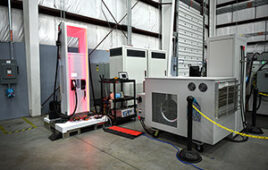Blacklight is Up and Running at the PSC
 Blacklight: The SGI Altix UV1000 system Blacklight: The SGI Altix UV1000 system |
Researchers are making productive use of Blacklight. This new system, which the Pittsburgh Supercomputing Center (PSC) acquired in, features SGI’s scalable, shared-memory computing platform and associated disks. Called Blacklight, the SGI Altix UV1000 system’s extremely large, coherent shared-memory opens new computational capability for U.S. scientists and engineers. Featuring 512 eight-core Intel Xeon 7500 (Nehalem) processors (4,096 cores) with 32 terabytes of memory, Blacklight is partitioned into two connected 16-terabyte coherent shared-memory systems — creating the two largest coherent shared-memory systems in the world.
Blacklight is now available for research through the TeraGrid allocation process. “Because of the extraordinary memory size and relative ease of programming made possible by this system’s shared-memory structure, scientists and engineers will be able to solve problems that were heretofore intractable,” said PSC scientific directors Michael Levine and Ralph Roskies in a joint statement. “For many research communities — including data analysis and many areas of computer science — it will open the door to use of high-performance computation and thereby expand the abilities of scientists to ask and answer questions.”
Forty-three users representing eighteen research groups have already begun to use PSC’s Blacklight for projects in machine learning, natural language processing, software security, analysis of molecular biology simulations, extreme-scale performance engineering, chemistry, fluid dynamics, the early universe, condensed matter, seismic analysis, and genomics. “Researchers are extremely excited about what they will be able to achieve with 16 terabytes of coherent shared memory, or even accessing all 32 terabytes, as can be accomplished with a bit more programming,” says Nick Nystrom, PSC’s director of strategic applications. “Also revolutionary is that Blacklight offers unparalleled ease of use for rapidly testing new ideas and for expressing complex algorithms, dramatically increasing users’ productivity.”
In computer terms, “shared memory” means that a system’s memory can be directly accessed from all of its processors, as opposed to distributed memory (in which each processor’s memory is directly accessed only by that processor). Because all processors share a single view of data, a shared memory system is, relatively speaking, easy to program and use. Coherence, a feature related to the synchrony of read-write operations by different processors within the system, is important for rapid expression of algorithms and in many large data-analysis tasks.




